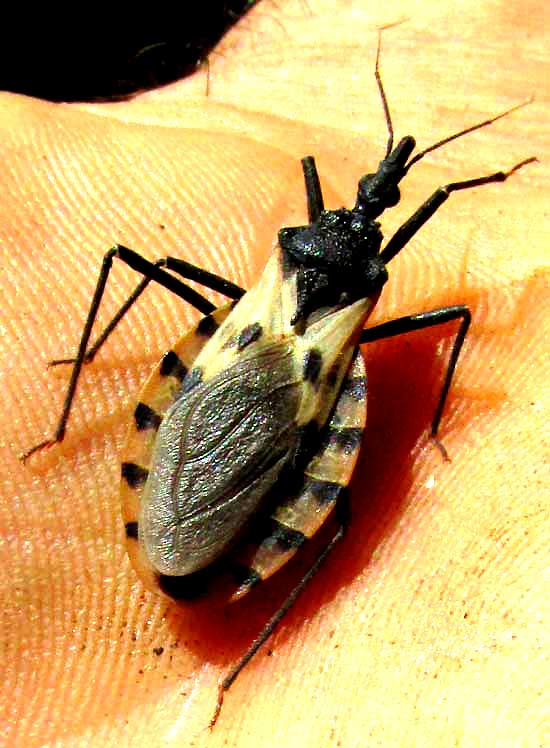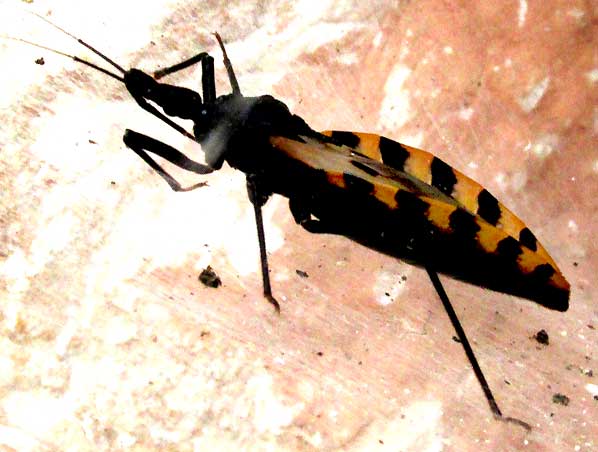Excerpts from Jim Conrad's
Naturalist Newsletter
from the June 11, 2017 Newsletter issued from Rancho Regenesis in the woods ±4kms west of Ek Balam Ruins; elevation ~40m (~130 ft), N20.876°, W88.170°; north-central Yucatán, MÉXICO
KISSING-BUGS AND CHAGAS DISEASE
Sometimes on the walls of little family stores, doctors' offices and public buildings in this area you see a blown-up picture of a Triatomine Bug, sometimes known as a Kissing Bug. That explains why when the other day a Kissing Bug showed up on the hut's floor, I recognized him. I'd been waiting for him, and you can meet him below:

That's TRIATOMA DIMIDIATA, one of several species of "Triatomine Bug." Triatoma dimidiata is distributed from central Mexico south through all of Central America into northern South America. The reason Kissing Bug pictures are posted in so many public places around here is that they spread Chagas Disease, which is a problem in the Yucatan. In the warmer US states, Chagas Disease also is spread by bugs of this genus, but not by our species. In the US eleven different species of kissing bugs have been documented. Over half the Kissing Bugs submitted to researchers in Texas were found to be infected with the Chagus Disease parasite.
Chagas Disease can kill by causing heart failure, but it takes years to develop to its final stages. For years during the disease's early phases the patient suffers vague, hard-to-diagnose symptoms often shared with many other diseases, including fever, headache, enlarged lymph glands, muscle pain, etc. More information on its signs and symptoms are provided on a World Health Organization page at https://www.who.int/en/news-room/fact-sheets/detail/chagas-disease-(american-trypanosomiasis)
That page tells us that Chagas Disease affects 6-7,000,000 people worldwide, mostly in Latin America. Triatomine Bugs like our Triatoma dimidiata carry the microscopic parasite Trypanosoma cruzi, which causes the disease. A 2007 study by Guzman-Tapia and others found our Triatoma dimidiata Kissing Bug to be fairly common in the Yucatan's capital city Mérida, and surrounding villages. Nearly half the bugs collected for that study carried the Chagas Disease organism.
The bugs, which normally are active at night, usually bite exposed skin, and then defecate close to the bite. The parasites enter the body when the person unthinkingly smears the bug's feces or urine into the bite, the eyes, the mouth, or any break in the skin.
The disease is easily treated with almost 100% recovery, if attended to soon after the infection. However, its vague symptoms are so hard to diagnose that often infected people suffer for years, and maybe die, without knowing what they have.
I always sleep beneath a mosquito net, but sometimes I awaken to find that in the night an elbow, foot or my butt has been pressed against the net's side, where an itching sore has developed. The Kissing Bug is always the first thing I think of then. However, I'm hoping that the net keeps the Kissing Bugs from pooping onto my skin, and it's the poop that's the main problem, not the bite.
issued on July 12, 2019 from near Tepakán, north-central Yucatán state; elevation ~9m (~30 ft), N21.053°, W89.052°; MÉXICO
KISSING-BUGS AND MY MOSQUITO NET
The first morning after we'd put the new roof onto the rock hut I live in I awoke with seven kissing-bugs INSIDE my mosquito net. My hands and feet were itching like crazy where, I assume, they'd extracted my blood. I remembered that line in my earlier entry, "A 2007 study by Guzman-Tapia and others found our Triatoma dimidiata kissing-bug to be fairly common in the Yucatan's capital city Mérida, and surrounding villages (Tepakán is a surrounding village). Nearly half the bugs collected for that study carried the Chagas Disease organism." And Chagas Disease can make life miserable for a long time and then, if untreated, kill you. The only silver lining in this cloud is that with my approaching 72 years of age, I don't have to worry about the disease killing me a long time from now.
The only way the bugs could have entered my mosquito net was by squeezing beneath the net's sides resting on the floor. At Ek Balam I saw numerous kissing -bugs walk several feet across open ground and approach a sleeping dog, rear up and start sucking blood, so apparently these bugs habitually approach by walking. Mosquitoes will bounce off a mosquito net's walls interminably without ever going low, but these Kissing Bugs are something else.
On the second night I weighed down the net's sides with rolled-up towels and such. Next morning only three Kissing-Bugs were inside my tent and my hands and feet were itching less. Finally I sewed together the net's bottoms, making a tube open at one end so I could enter and leave, and weighing down the net at the entry very securely. Now for a couple of weeks no bugs have gotten inside, though most mornings I find one or more on the net's outside walls. Only rarely does one get inside. I collect these bugs and deposit them on the funnel web of a big spider living in a hole between a couple of the rock hut's stacked rocks. Below, you can see a caught bug on the web moments before the spider pounced. In that picture notice the stiletto-like, blood-sucking proboscis angled below the bug's head.
